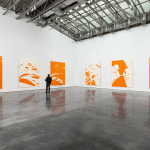Flourishing interest at international festivals and record auction prices demonstrate an upsurge in interest for contemporary Chinese and Chinese-American art, and American museums have responded by organizing a plethora of group shows. Some museums, recognizing China’s increasing global importance, are earnestly committed to incorporating contemporary Chinese art into their permanent collections. Even China is beginning to value their own once-shunned contemporary artists.
The New Britain Museum in Connecticut is showing “Contemporary Combustion: Chinese Artists in America, “ curated by Tita Hyland on view through Oct. 14. “As more Chinese come to the United States to visit or live, Chinese culture plays an increasingly important role here,” says Hyland in the Hartford Courant. “Most of this work has been created in the last 10 years and is a tempting glimpse of what lies ahead.” Featuring ten Chinese-American artists, the show examines the way the two cultures interact.
Matt Eagan, art critic for the Hartford Courant, says that there are radical departures from traditional Chinese painting. “The result is a collision of cultures and a fair warning for what lies ahead.” Read more. Artists in the exhibition include painters Zhang Hongtu, C.C. Wang, Arnold Chang, Hung Liu.
On the west coast, the Museum of Contemporary Art
in Los Angeles has partnered with East West Bank to buy several pieces by contemporary Chinese artists, including paintings by Cai.Xu and Li Jin. Suzanne Muchnic reports that in the LA Times: “East West Bank has purchased a $2-million collection of Chinese contemporary art for the Museum of Contemporary Art in Los Angeles, but you’ll have to go to the bank’s headquarters in Pasadena to see it. Under terms of an unusual agreement, MOCA curators selected 11 paintings, drawings, sculptures and photographs by six artists — including leading figures such as Xu Bing and Cai Guo-Qiang — and the bank paid for them. Starting Thursday, the works will be on public display at the bank, but they will also be available for exhibition at the museum and will become part of its permanent collection in 2026. ‘This is a community thing,’ Dominic Ng, the bank’s chairman and chief executive, said this week. ‘I was not interested in getting these artworks for corporate decoration or pure appreciation. It’s important to provide exposure for Southern California residents who might not have an opportunity to see contemporary art from China.'” Read more.
In the NYTimes, Robin Pogrebin writes that NY’s Asia Society is beginning to collect contemporary Asian art. Let’s hope they include a good number of paintings along with the video and installation pieces. Pogrebin reports: “Asia Society was among the first American museums to establish a program of contemporary Asian art exhibitions featuring works by artists like Cai Guo-Qiang, Shirin Neshat, Shahzia Sikander, Dinh Q. Le and Montien Boonma. It has also commissioned site-specific installations by artists like Xu Bing, Sarah Sze and Ms. Sikander. Interest in contemporary Asian art has been building among collectors worldwide, prompting auction houses to expand their sales of such works in New York, London, Hong Kong and elsewhere. And from New York to Houston to Denver to Seattle, museums in the United States have been bolstering their contemporary Asian holdings and organizing more shows in the field. ‘It�s kind of slowly happening,’ Ms. Chiu said. ‘I think we�ll see museums get into it more and more.’ The environment is likely to be increasingly competitive.” Read more.
In the NYTimes, David Barboza reports that China’s leading contemporary artists are finally being recognized in their own country as well: “For years their work could not be exhibited in China, but now the country�s leading contemporary artists are being courted by major art collectors abroad and their paintings set records at international auction sales. A local government in Sichuan Province � the area in western China known for its natural beauty, spicy food and talented painters � is taking notice. It has offered to give eight contemporary artists, all under 60, their own personal museums to operate. The group includes some of China�s best-known avant-garde artists: Zhang Xiaogang, Wang Guangyi, Fang Lijun, Yue Minjun, Zhou Chunya, He Duoling, Zhang Peili and Wu Shanzhuan. All have accepted, and Dujiangyan, a city near the provincial capital, Chengdu, will soon begin construction on an 18-acre plot of land. The museums are scheduled to open in October 2008.” Read more.






















